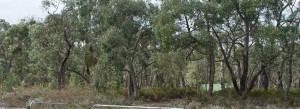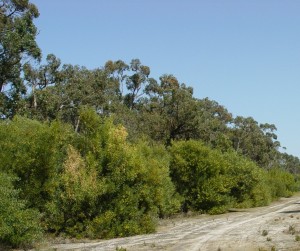A major bushland weed in NGT’s focal region – Sallow Wattle
Have you ever wondered as you drive around our region what that tall shrub is, with pale green foliage and long spikes of bright yellow wattle flowers that come out during the winter?
Have you noticed that you are seeing more and more of it (especially after fire), and that it is turning up in places you never remember seeing it before?
This “native” invader, Sallow Wattle (Acacia longifolia var. longifolia), is indigenous to the forests of Gippsland and beyond along the east coast, but has been moved around Australia and the world (for revegetation and in the nursery trade), where it has “jumped the fence” and is now having quite a dramatic negative impact in a range of ecosystems.
The other day I had the chance to chat to Bruce McInness from the Wimmera CMA, who is also the president of the Laharum Landcare Group, and it turns out we both share a strong interest in Sallow Wattle and trying to deal with what has become a landscape-scale invader of woodlands and heathlands in our region.
I was really pleased to hear that the Laharum Landcare Group has commenced a project to work towards control of the species in private bushland adjacent to the Grampians National Park, and wish them well with their project.
For those of you based in South Australia, you may be interested to know that I worked with the Native Vegetation Council a few years ago to develop guidelines for control of Sallow Wattle in the South East NRM Region, which make it possible to get on with managing this problematic “native” species on bushland on the SA side of the border. For more information follow this link: 4.7_Guidelines_acacia longifolia_Aug2010
It is worth getting to know Sallow Wattle, because there are many areas it has not yet reached, and early intervention removing isolated plants (before a seed bank is established) is the best way to keep your bushland weed free.




